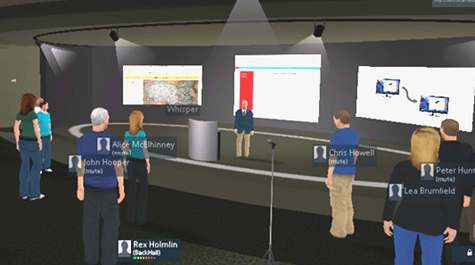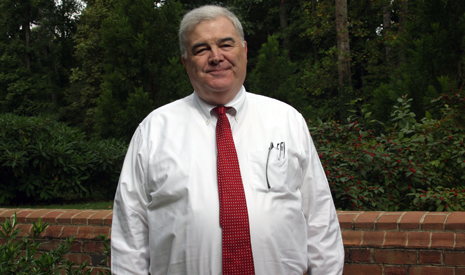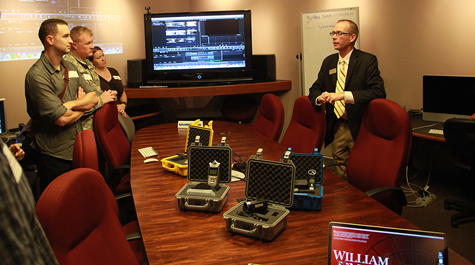Welcome to the e-learning lab
The hype of massive online courses known as MOOCs has consumed much of the e-learning conversation in higher education over the past several years. But in reality, there are more ways to utilize online teaching technology outside the context of the mega class.
William & Mary has recently undertaken a new venture to examine how learning technologies can enhance instruction. A number of experimental course initiatives and departmental projects using technology and tools instructionally are underway across the university.
The rapid growth of e-learning activities prompted the university to create a new position to oversee and coordinate the launch of technology-enhanced projects. Provost Michael R. Halleran appointed Gene Roche, an educational technology professor in the School of Education, as the first director of university e-learning initiatives in September.
{{youtube:medium|5S6PbAPcCBk, Gene Roche discusses e-learning.}}
Roche estimates there are 30 to 40 initiatives altogether – many of which began at the grassroots level. Graduate and professional schools have been leaders in exploring virtual technology. He notes the Business School’s ongoing work in exploring a blended MBA program to leverage face-to-face instruction and web-based learning delivery.
A May 2013 report by the Digital Educational Technology Committee to the provost noted faculty are already using two modes of web-based instruction: synchronous (where students learn at the same time) and asynchronous (self-directed learning where students learn at different times).
Roche said that although W&M is a traditional institution with a reputation for high-touch teaching, the faculty and administration understand that virtual forces are transforming higher education.
He points to Penn State, which recently announced an online version of its master’s program in higher education – rated in the top five by U.S. News and World Report. Georgia Tech is now offering an online master’s degree in computer science that could enroll up to 10,000 students by partnering with Silicon Valley’s Udacity.
“William & Mary has no choice whether to respond,” said Roche. “But it’s how we respond that matters.”
Halleran said the university must embrace what it is already doing extremely well and explore the most appropriate areas of e-learning.
“In doing so, we will improve student learning as we experiment, save and/or create resources where we can, and avoid irrelevance – all so we can focus powerfully on our essential strengths,” Halleran recently told the Board of Visitors. “Engaging students in the excitement of learning and discovering on a human scale with high touch – this is our fundamental competitive advantage.”
{{youtube:medium|f6WP196UJD8, W&M faculty discuss experimental course initiatives.}}
Virtual Collaboration
This summer the Mason School of Business’ Center for Corporate Education tested an online prototype course in project management. The Center has designed customized education programs for public and private organizations since 1990 and is looking to expand its reach through open-enrollment courses.
Center Program Manager Martha Orr said two sessions of the continuing education course were offered this fall to a targeted group of organizations and alumni. Each session enrolled about 20 students, said Orr. Individuals are located across the U.S. from California to Massachusetts and come from various career fields such as marketing, healthcare and accounting. Two students are located in foreign countries for session two.
Adjunct faculty member Rex Holmlin is teaching the course asynchronously. He uploads pre-recorded lectures for students to watch at their leisure before coming online to work virtually on assignments or conduct project discussions. The virtual space is a replication of Miller Hall, complete with meeting rooms, a lounge area and movable furniture.
“This course is an opportunity for us to reach out to an audience that we might not normally be able to serve because of their working schedules,” said Holmlin. “It also broadens our geographic reach.”
Floridian Peter Hunt, who completed session one, has taken several online courses at multiple institutions in pursuit of his MBA degree. He said the interactive digital learning platform provided virtual collaboration to engage digitally with his classmates and professor. Students were presented online as a virtual replica of themselves with the capability to walk, talk, sit and raise their hand.
“Even though I was in an e-learning environment, I still felt like I was part of the class because it was collaborative,” said Hunt. “When I would talk with Rex about projects I was working on, I really felt like I was sitting at a table and talking with him.
“By far, of all the educational institutions, William & Mary does e-learning right.”
A tailored Liberal Arts curriculum
Across campus, Professor of Applied Science Michael Kelley and his faculty colleagues from the Arts & Sciences are engaged in a conversation about best practices, resources and policies for online learning. Kelley is part of a 20-member working group being led by Dean of Undergraduate Studies John Griffin.
The faculty group has been charged by Dean Kate Conley to develop a framework for how e-learning could selectively support W&M’s Arts & Sciences curriculum.
Kelley has been a leader in adapting the technology for online teaching. For the past 12 years, he’s delivered his doctoral-level Introduction to Materials Characterization course synchronously to students located at several public universities throughout Virginia. This fall, he’s testing another approach by flipping the classroom – a form of teaching where students learn course material by watching a lecture Kelley has pre-recorded before class. Then, Kelley sits in Morton Hall and teaches class using statewide video technology to interact in real time with students.
“We use our time together to discuss, do problems and explore applications, which is much better than simply watching me lecture,” said Kelley. Because face-to-face time is limited, Kelley said he’s also able to cover more material during the semester.
Although asynchronous and synchronous learning models differ, Roche said e-learning techniques provide professors with two important benefits: individual mastery and personalization.
He uses the example of giving an online test to gauge students’ understanding of course material. If all but two students pass the test, he can then adjust the following class to personally help the students who failed while others work in small groups to apply what they’ve learned.
“As the technology for online education improves, faculty members will have even more information about how students are actually learning. I’ll know how long students spend on the exercises, whether or not they quit early, and how many answered the questions,” said Roche. “I can make better use of face-to-face time than I ever could before.”
This increased information, said Roche, will give professors the ability to gather lots of data on how students spend their time learning. And while some might view that as big brotherly, Roche takes a different stance.
“As a teacher, it allows me to help the student more,” he said.
Swem Library positioned to support
To support the digital revolution, Swem Library has proactively created a number of initiatives to help faculty and students.
Building on the capacities and expertise of its Media Center, last fall the library opened the Kyle Collaboration Lab. The high-tech space is a resource and designated place for faculty to work collaboratively with instructional designers, instructional technologists, media specialists and librarians.
“Faculty across campus have utilized the space to learn and explore techniques for developing online content,” said Troy Davis, director of Swem’s media center.
Additional resources offered by Swem include more than 300 online databases, thousands of ebooks and a highly popular service for faculty to drop-off media to be converted and digitized for use in the online classroom.
Associate Dean for Research and Public Services Lisa Nickel said librarians are actively engaged, too. They help faculty by preparing material and placing content online, assisting with research and access to primary source materials, the university’s archives or special collections and other course-related instruction research needs.
Looking ahead to blended programs
As versions of e-learning are becoming embedded in pedagogy and students increasingly expect the use of online tools as part of their education, Provost Halleran said the most important question to ask is: How does the university preserve and improve the W&M education in the current climate?
One solution is blended learning, also referred to as hybrid learning, which gives students the scheduling flexibility and socialization opportunities of the classroom. Research by the U.S. Department of Education shows blended learning is effective in terms of student learning outcomes and ranks high in satisfaction with students and instructors.
“The blended MBA program we’re exploring at the Mason School of Business, for instance, would build on the established full and part-time programs to offer a high-quality degree for working adults,” said Roche.
No date has been set for the program’s debut, said Roche. Once the framework for the program has been developed by the planning committee, faculty at the business school will vote to adopt the new curriculum.
Another important area is the continuation and expansion of the Creative Adaptation Fund award, with a greater emphasis placed on e-learning, said Halleran. Several pilot projects are under development, including a self-directed eLearning professional development course for faculty and the creation of a new blended introductory music course.


















